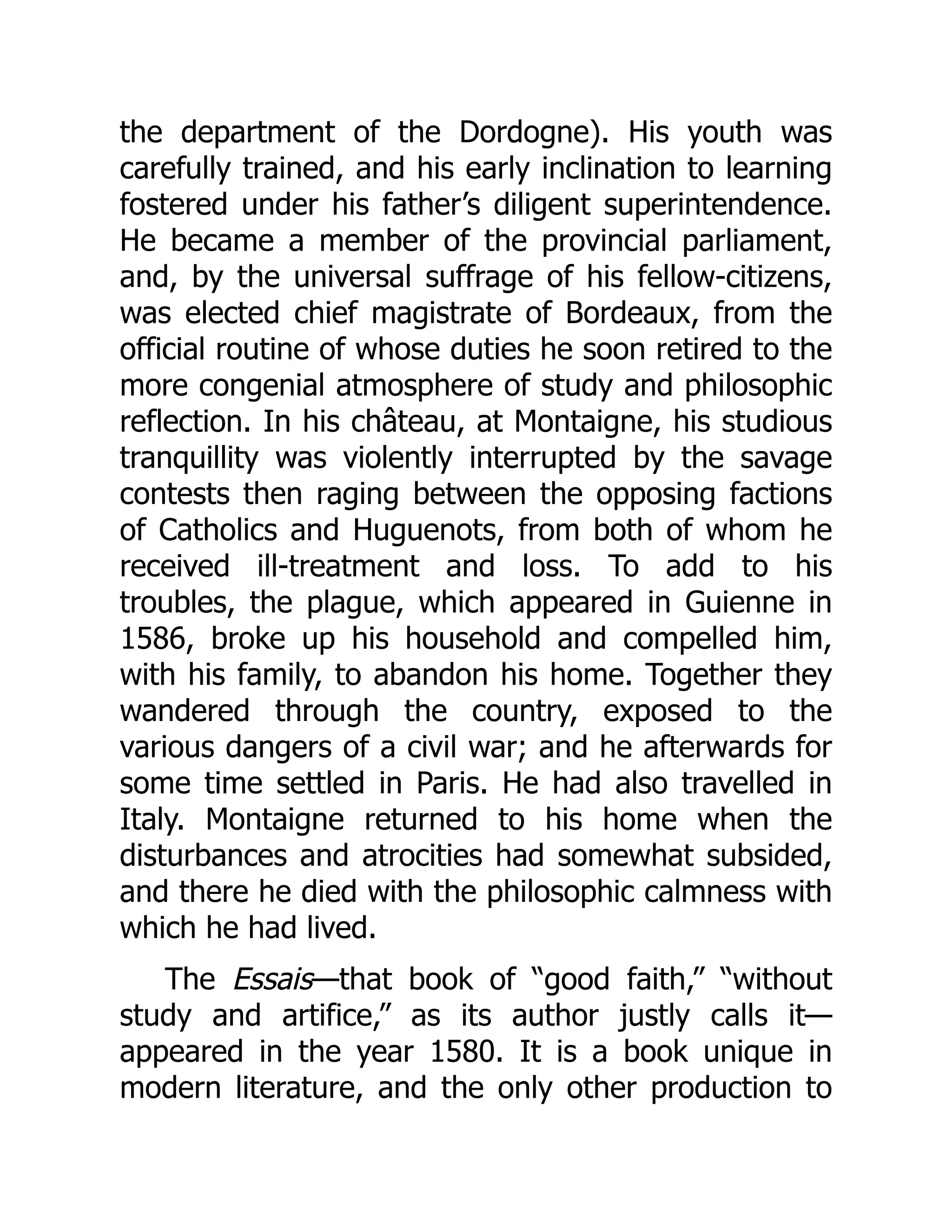Learning React Native Building Native Mobile Apps with JavaScript 2nd Edition Bonnie Eisenman Learning React Native Building Native Mobile Apps with JavaScript 2nd Edition Bonnie Eisenman Learning React Native Building Native Mobile Apps with JavaScript 2nd Edition Bonnie Eisenman

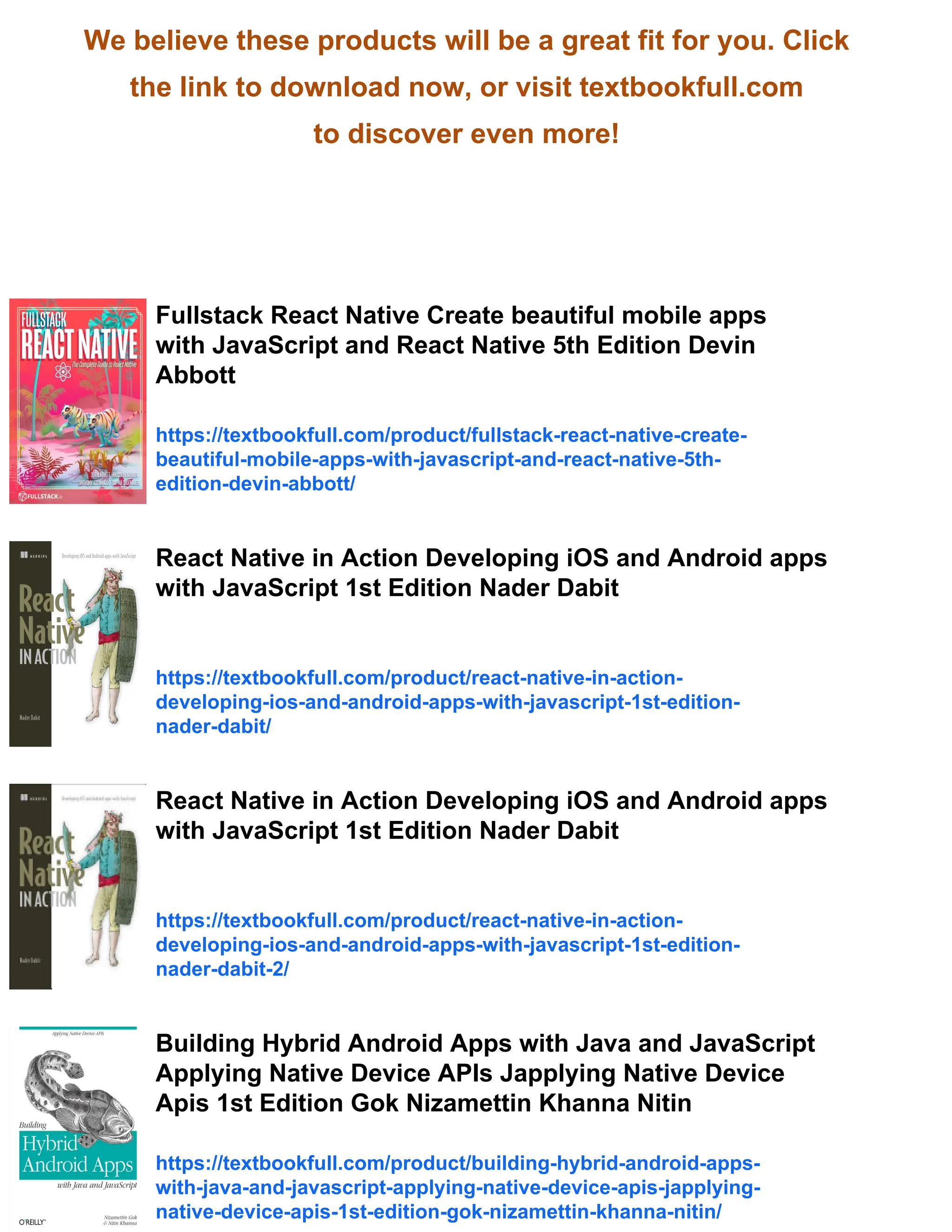

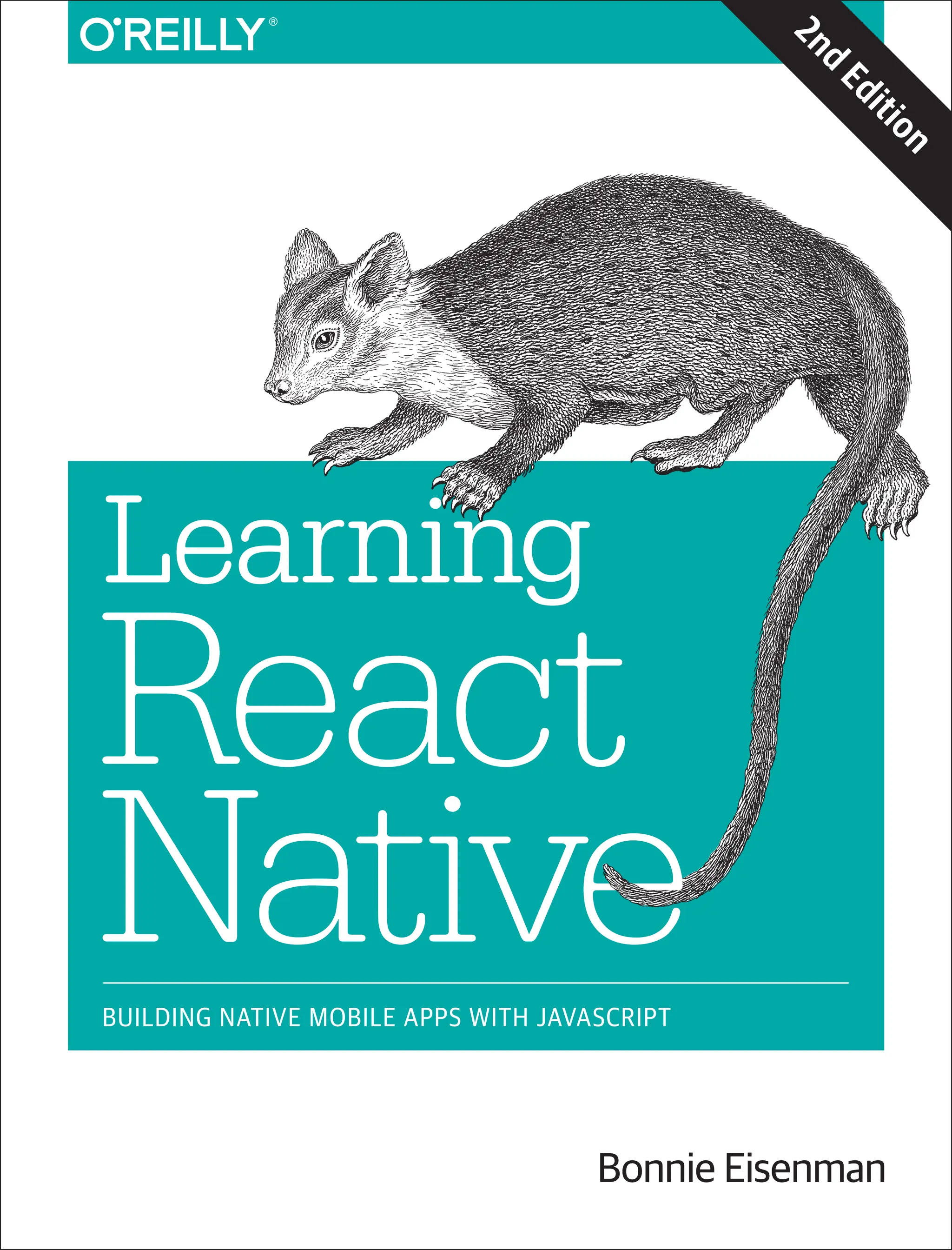

![978-1-491-98914-2 [LSI] Learning React Native by Bonnie Eisenman Copyright © 2018 Bonnie Eisenman. All rights reserved. Printed in the United States of America. Published by O’Reilly Media, Inc., 1005 Gravenstein Highway North, Sebastopol, CA 95472. O’Reilly books may be purchased for educational, business, or sales promotional use. Online editions are also available for most titles (http://oreilly.com/safari). For more information, contact our corporate/insti‐ tutional sales department: 800-998-9938 or corporate@oreilly.com. Editor: Meg Foley Production Editor: Nicholas Adams Copyeditor: Rachel Monaghan Proofreader: Gillian McGarvey Indexer: Judith McConville Interior Designer: David Futato Cover Designer: Karen Montgomery Illustrator: Rebecca Demarest December 2015: First Edition November 2017: Second Edition Revision History for the Second Edition 2017-10-23: First Release See http://oreilly.com/catalog/errata.csp?isbn=9781491989142 for release details. The O’Reilly logo is a registered trademark of O’Reilly Media, Inc. Learning React Native, the cover image, and related trade dress are trademarks of O’Reilly Media, Inc. While the publisher and the author have used good faith efforts to ensure that the information and instructions contained in this work are accurate, the publisher and the author disclaim all responsibility for errors or omissions, including without limitation responsibility for damages resulting from the use of or reliance on this work. Use of the information and instructions contained in this work is at your own risk. If any code samples or other technology this work contains or describes is subject to open source licenses or the intellectual property rights of others, it is your responsibility to ensure that your use thereof complies with such licenses and/or rights.](https://image.slidesharecdn.com/31477-250621061448-bf515544/75/Learning-React-Native-Building-Native-Mobile-Apps-with-JavaScript-2nd-Edition-Bonnie-Eisenman-6-2048.jpg)

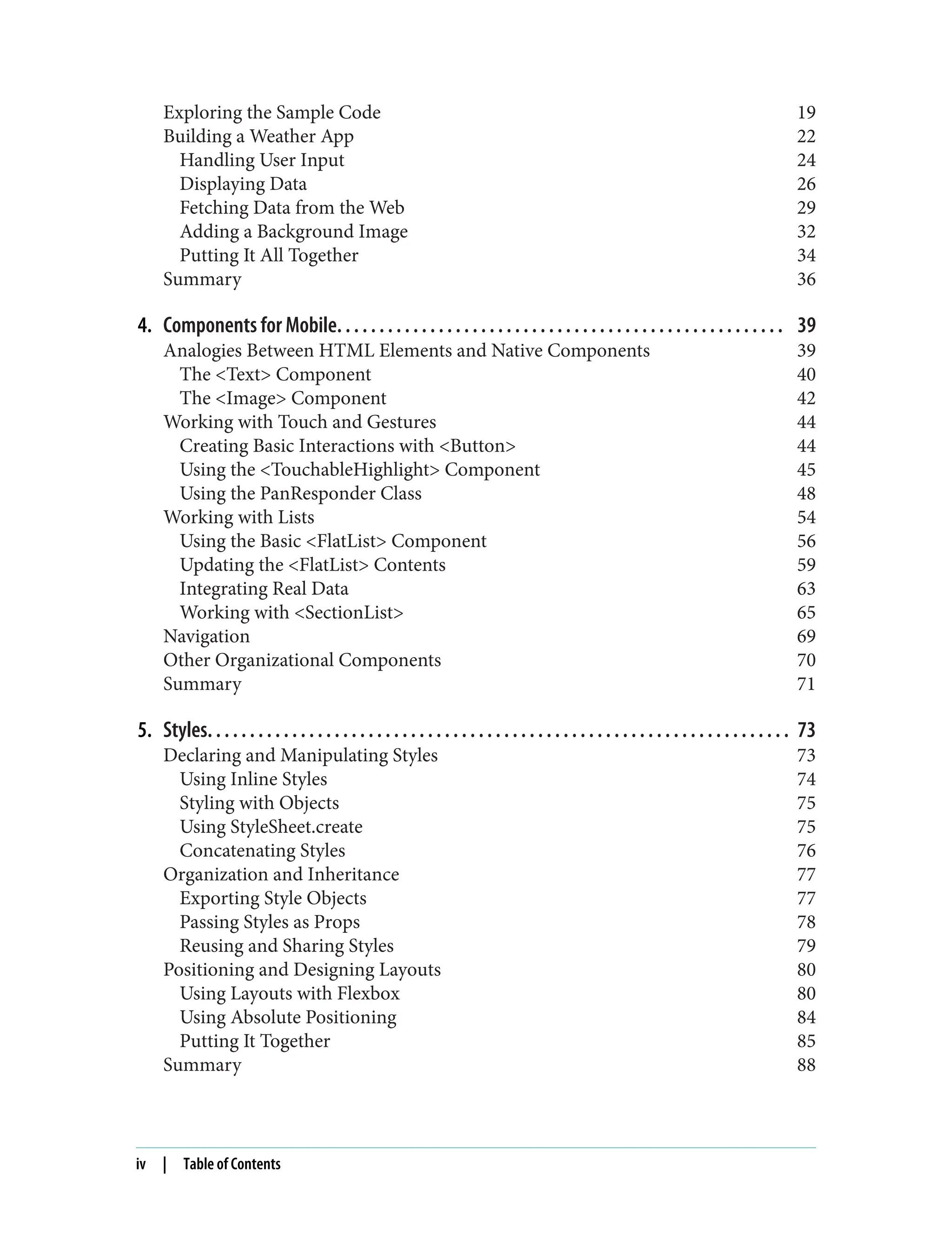
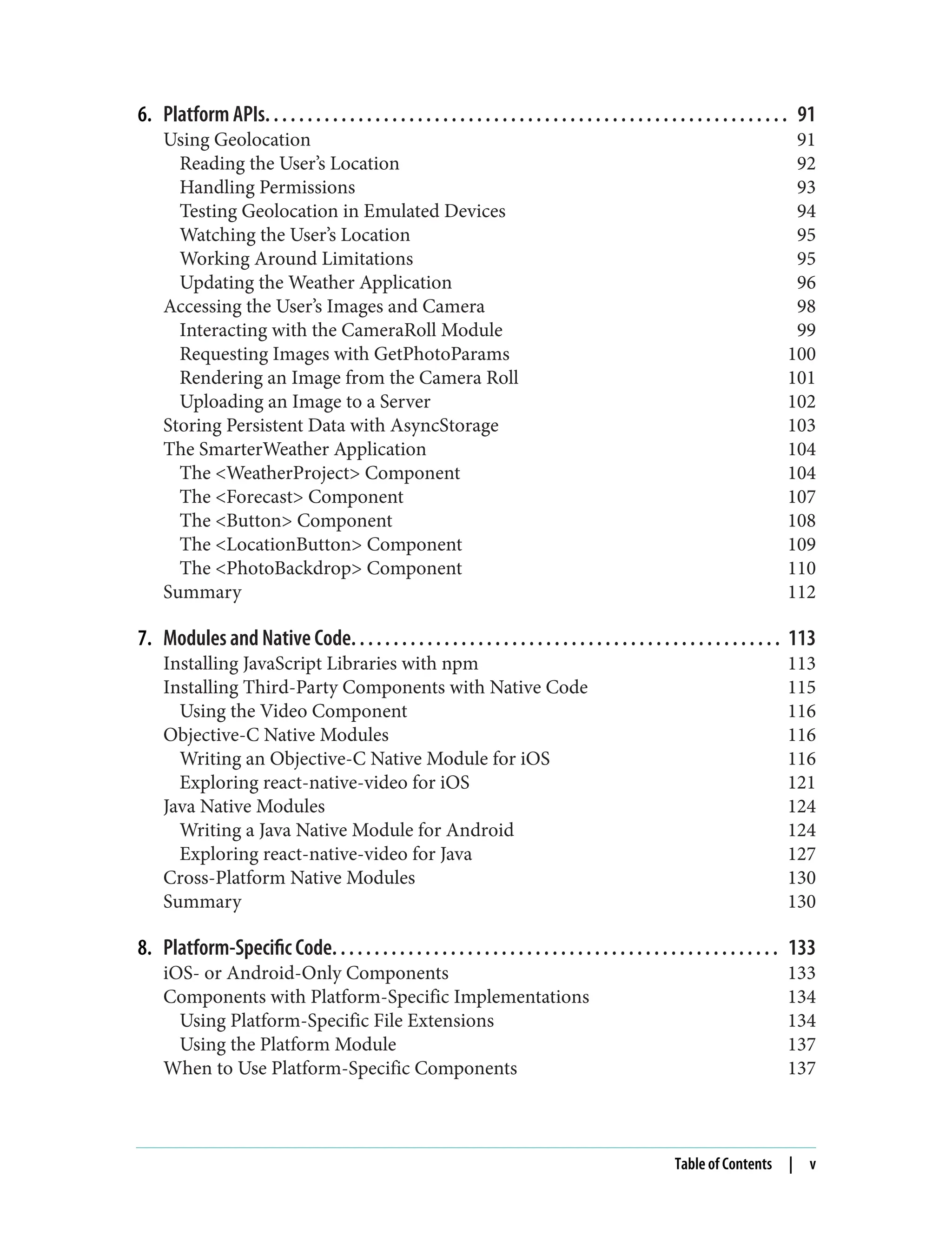

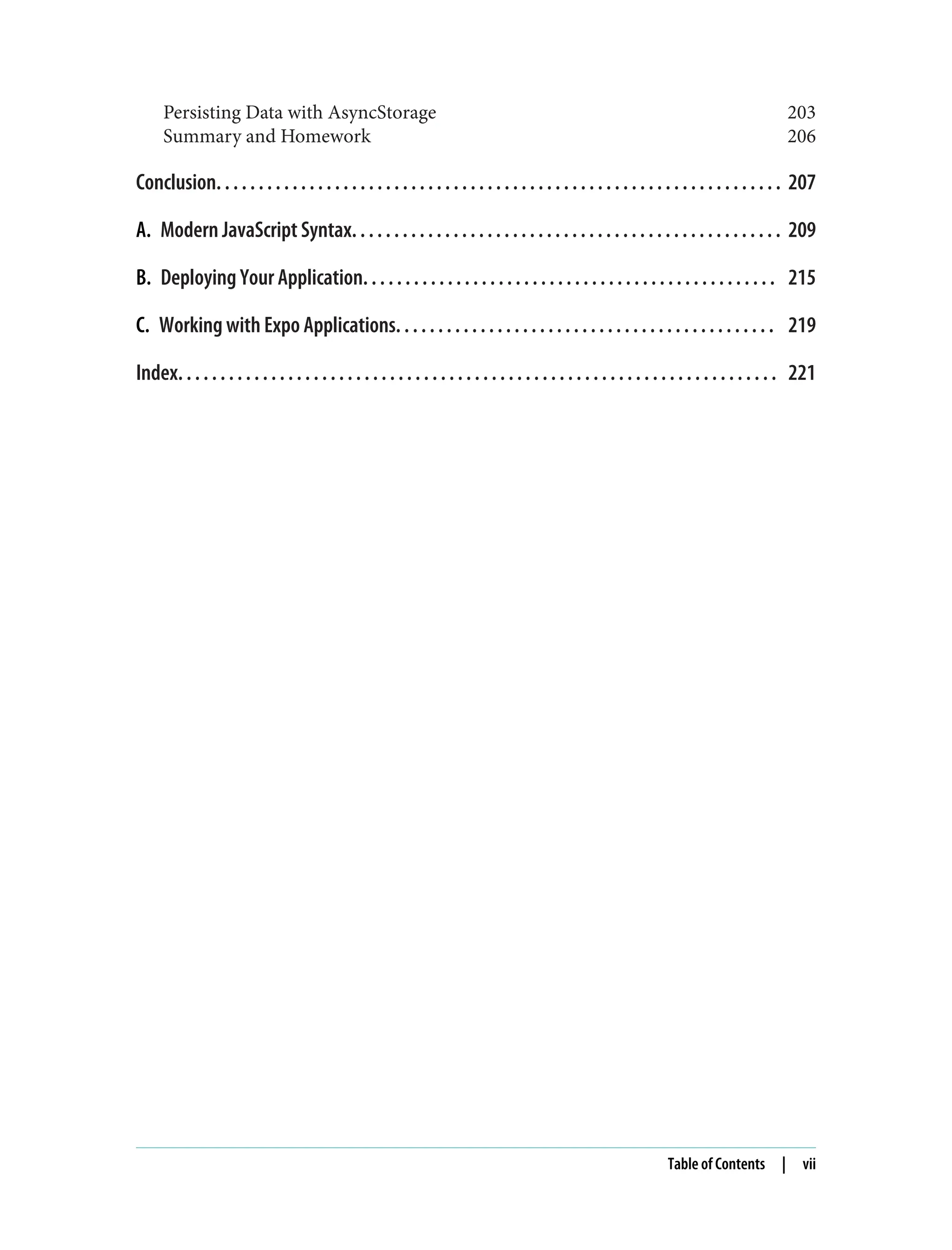

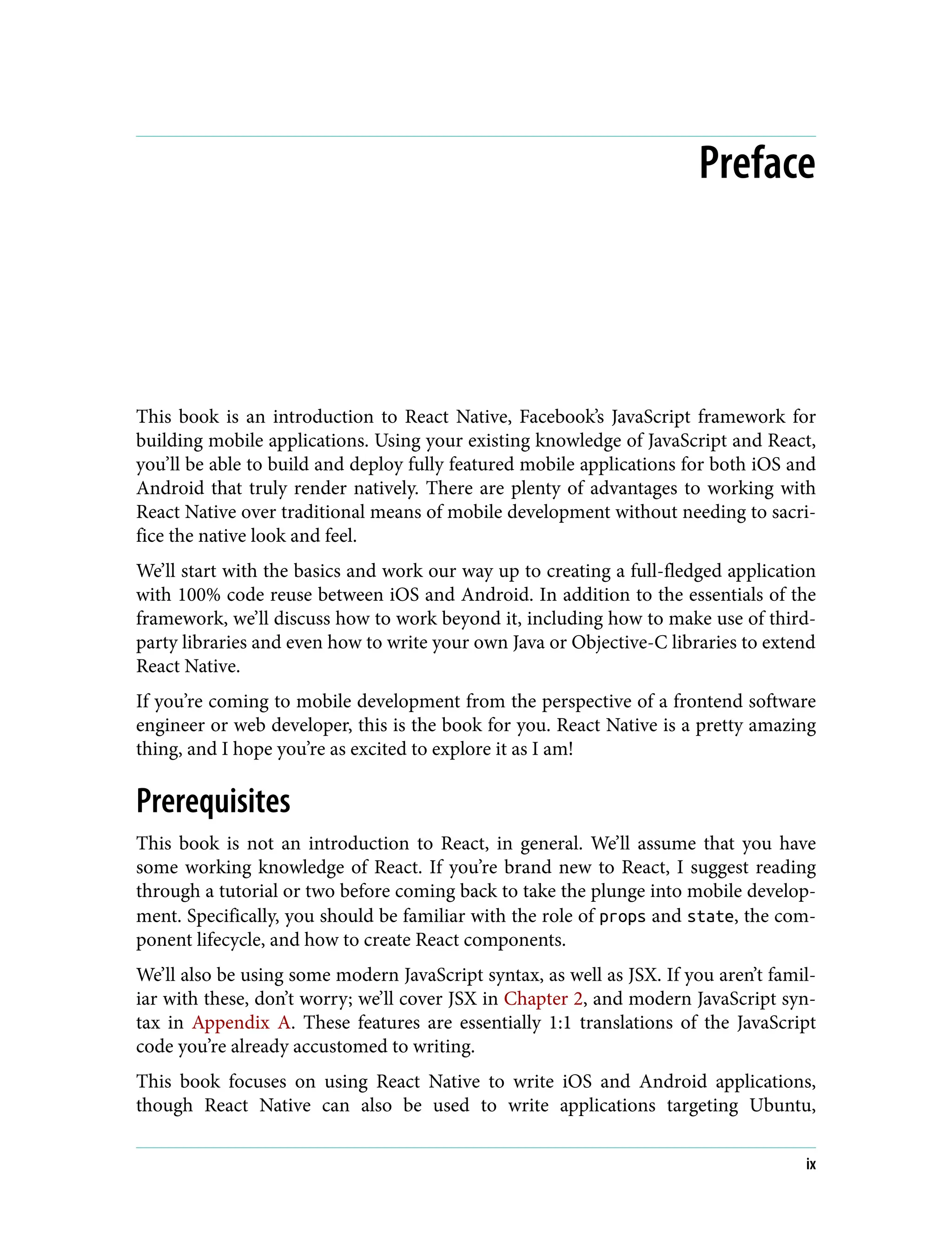

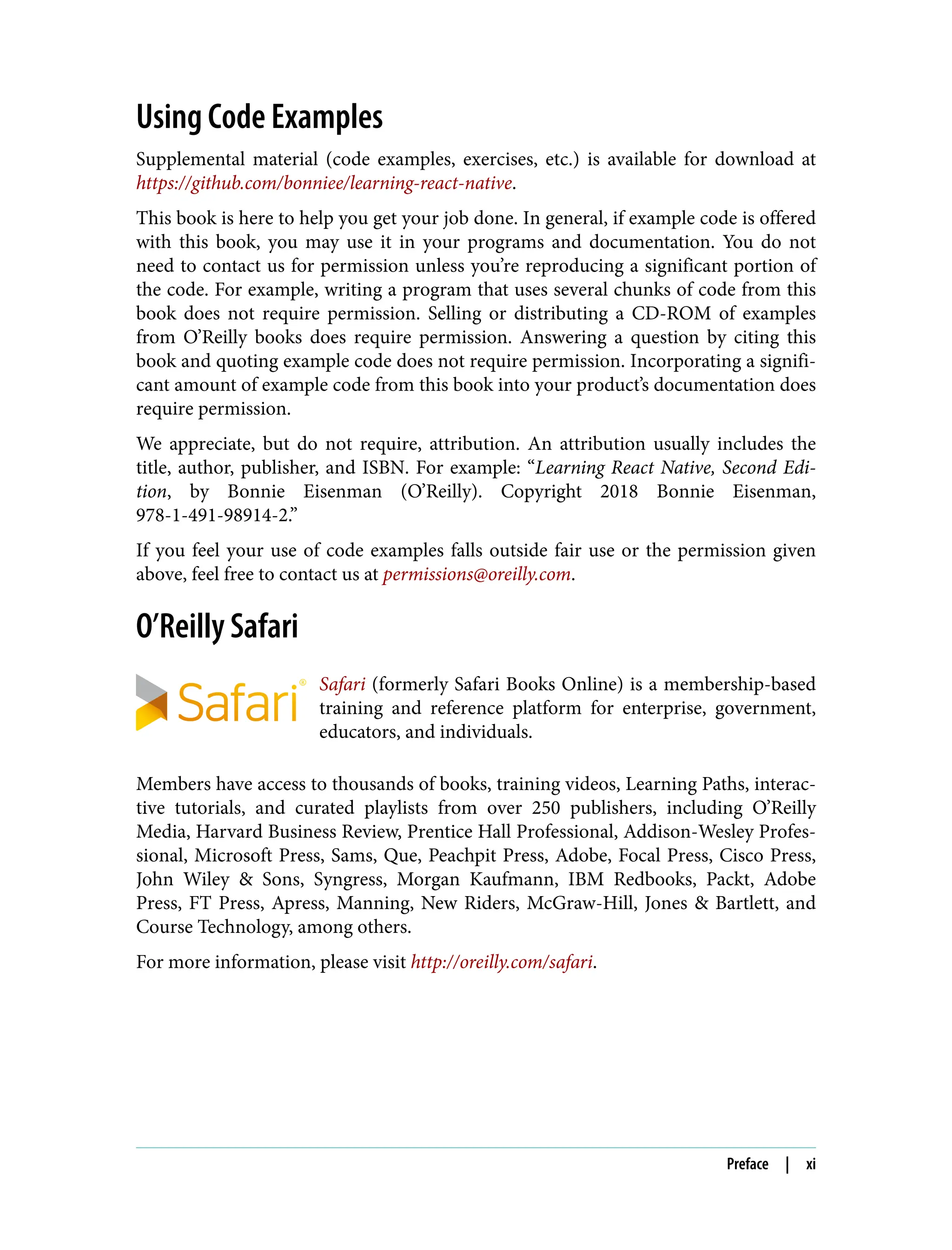
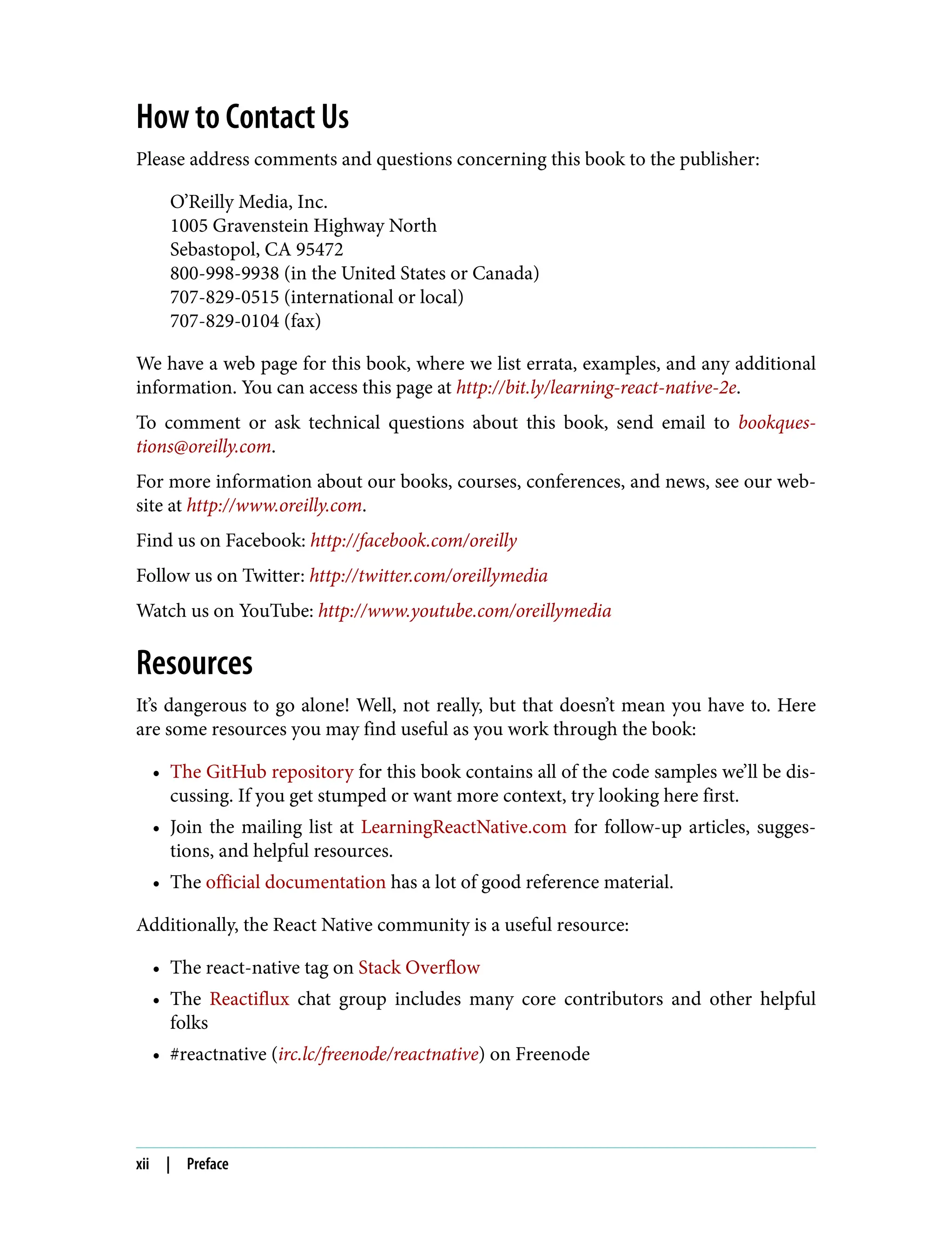
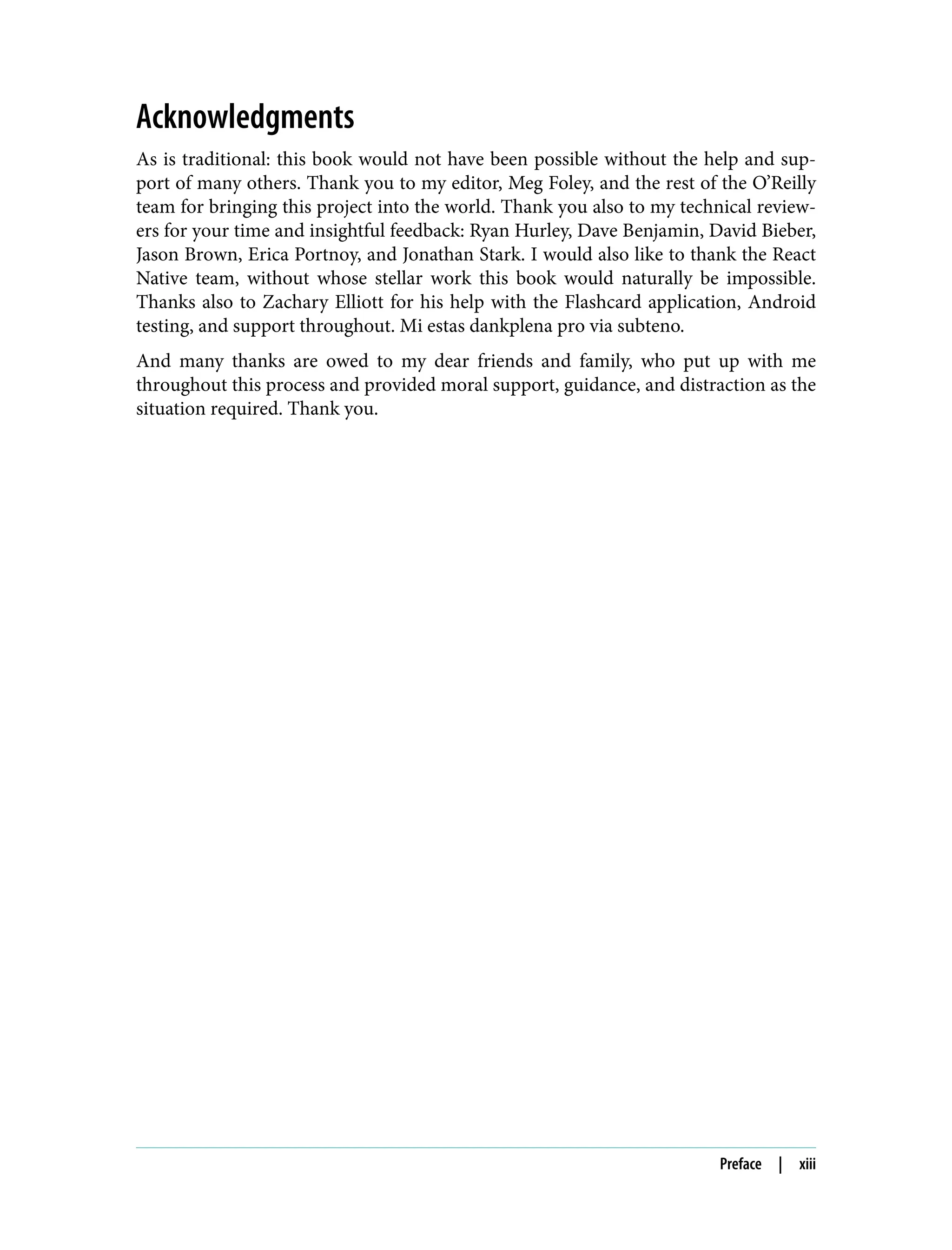

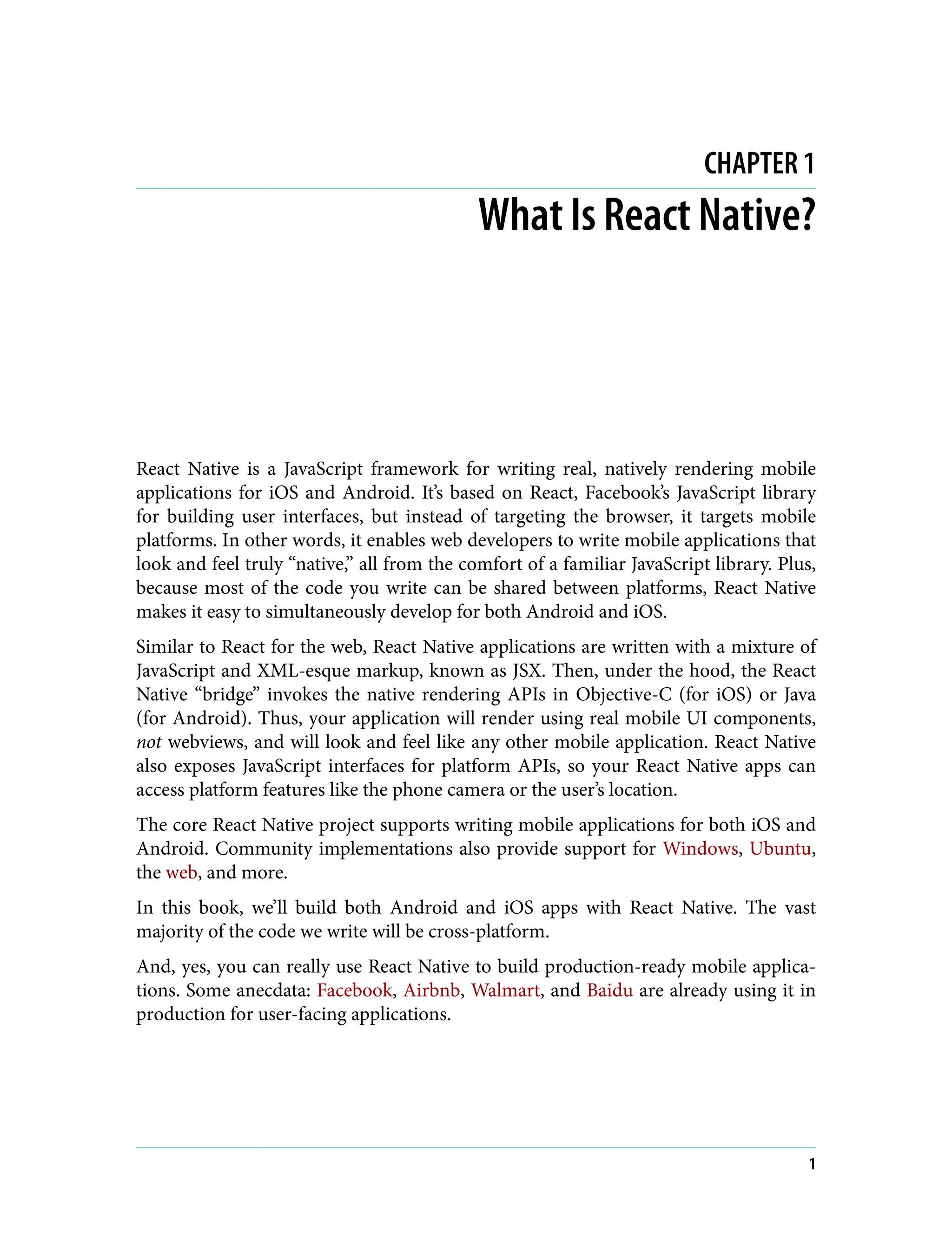
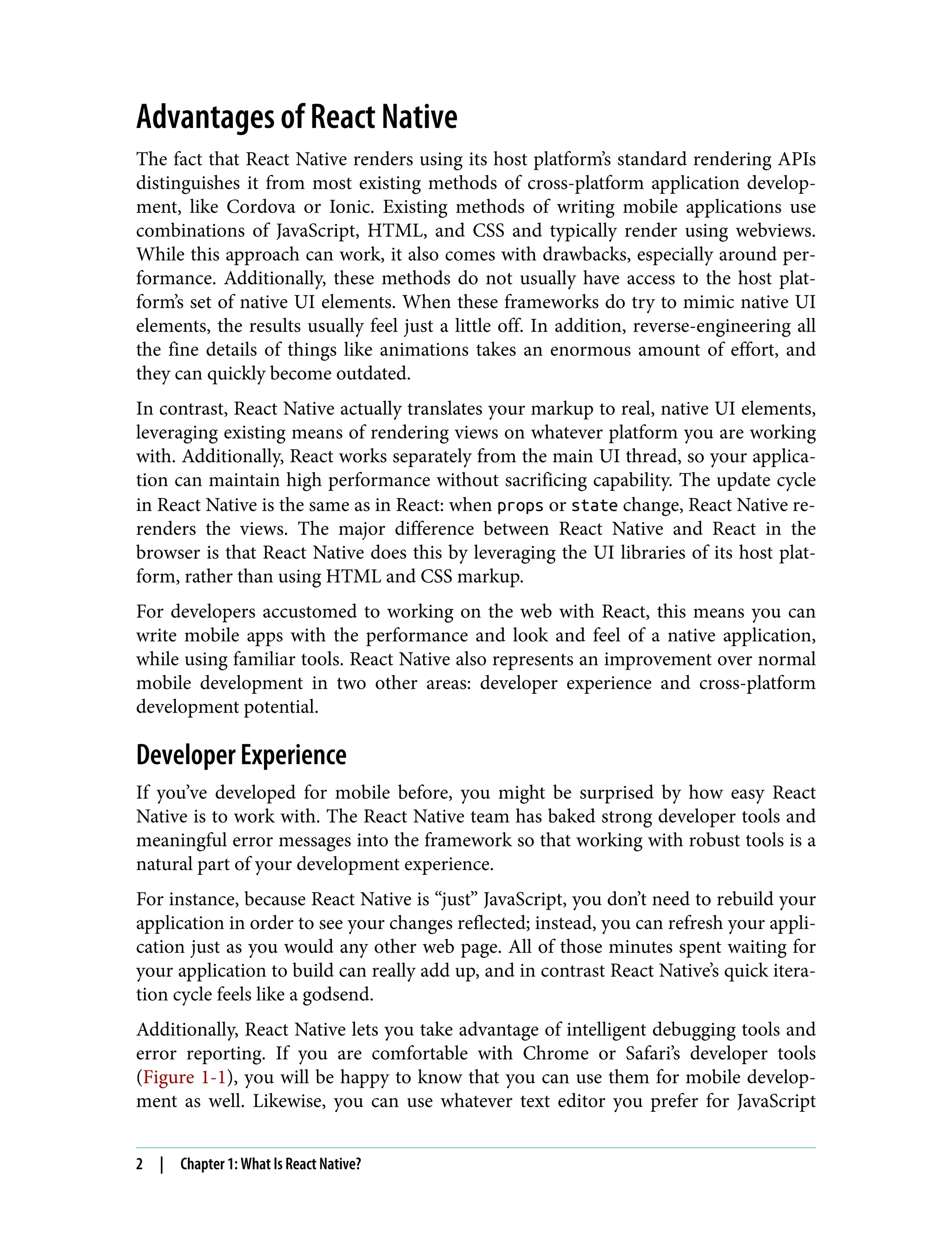

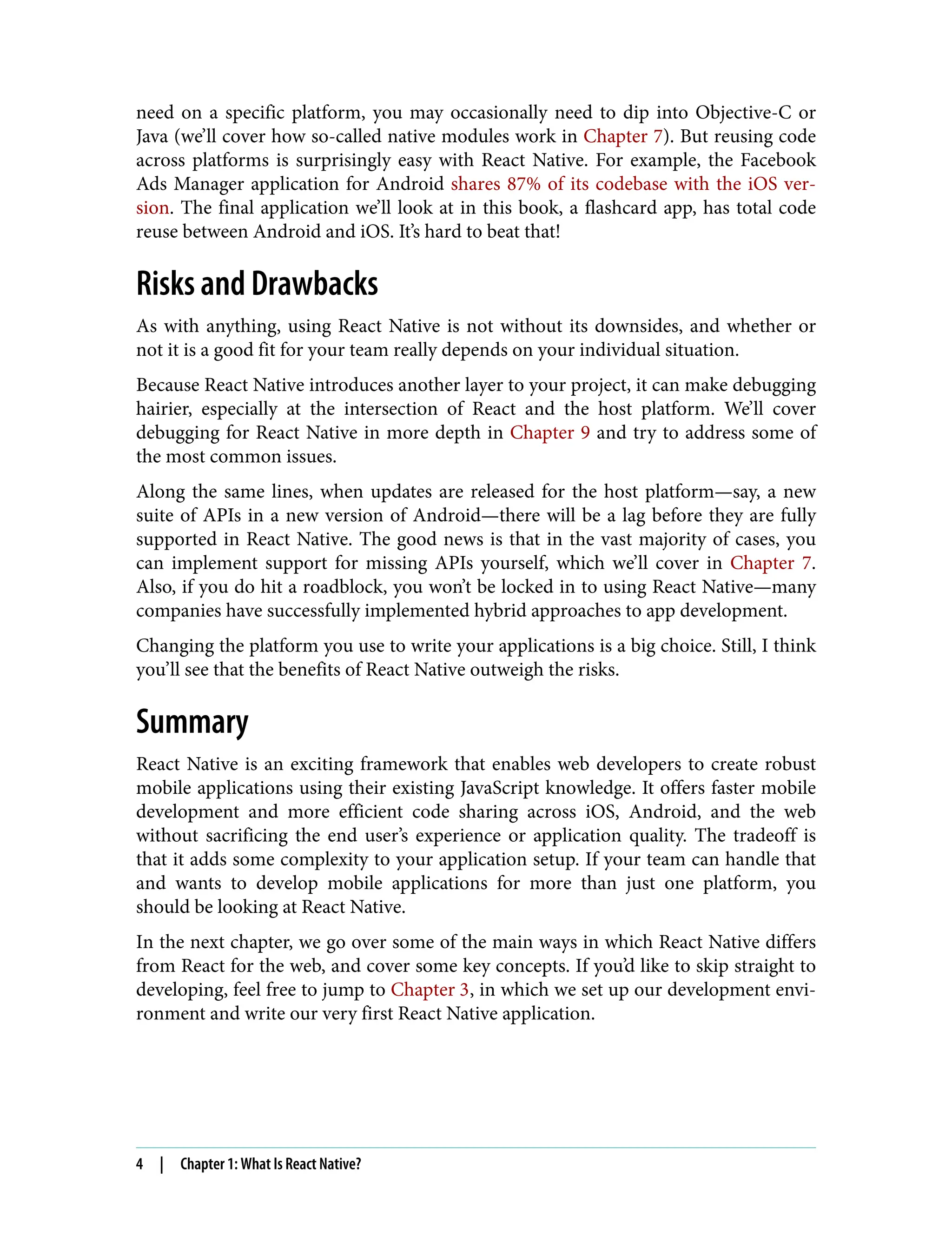


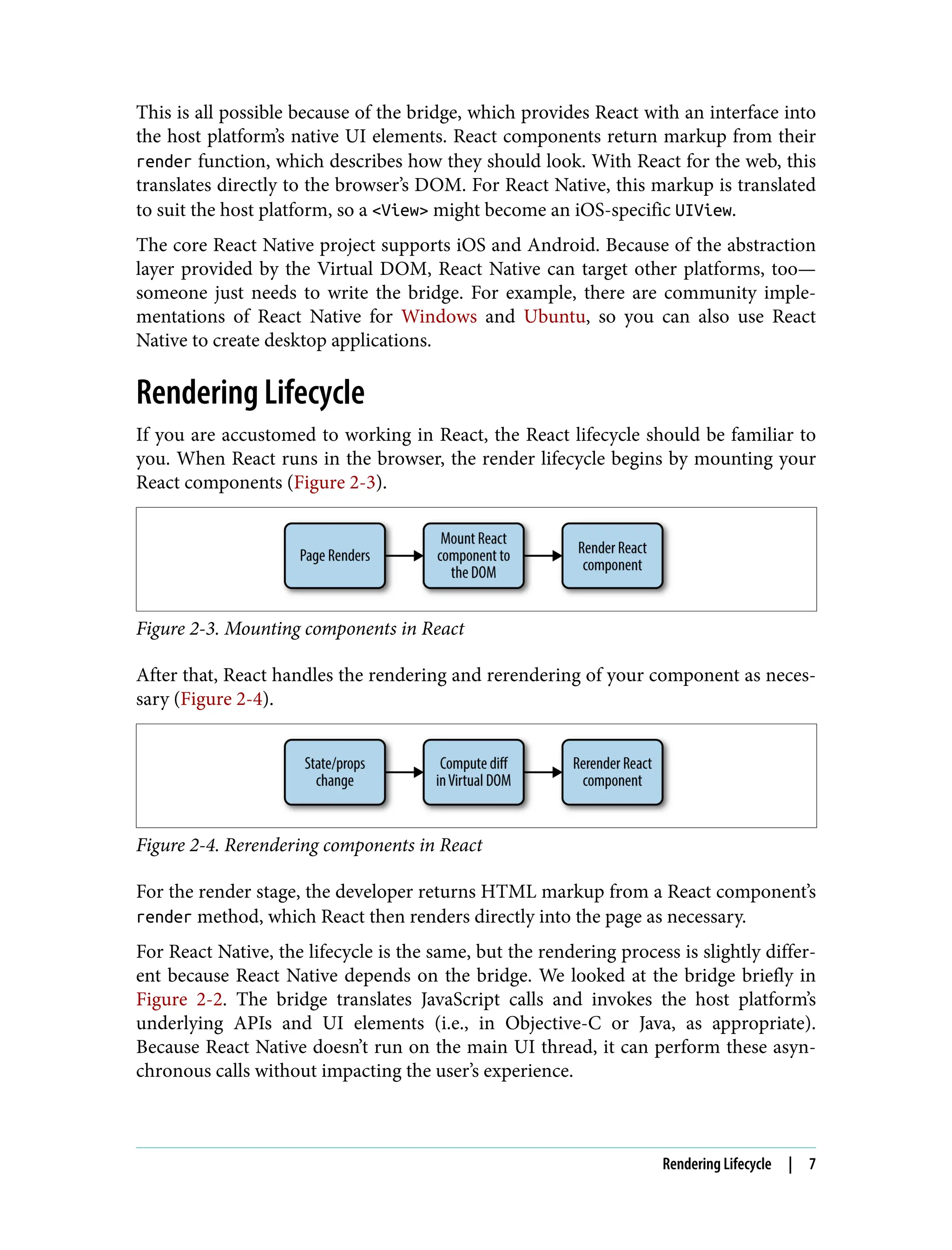
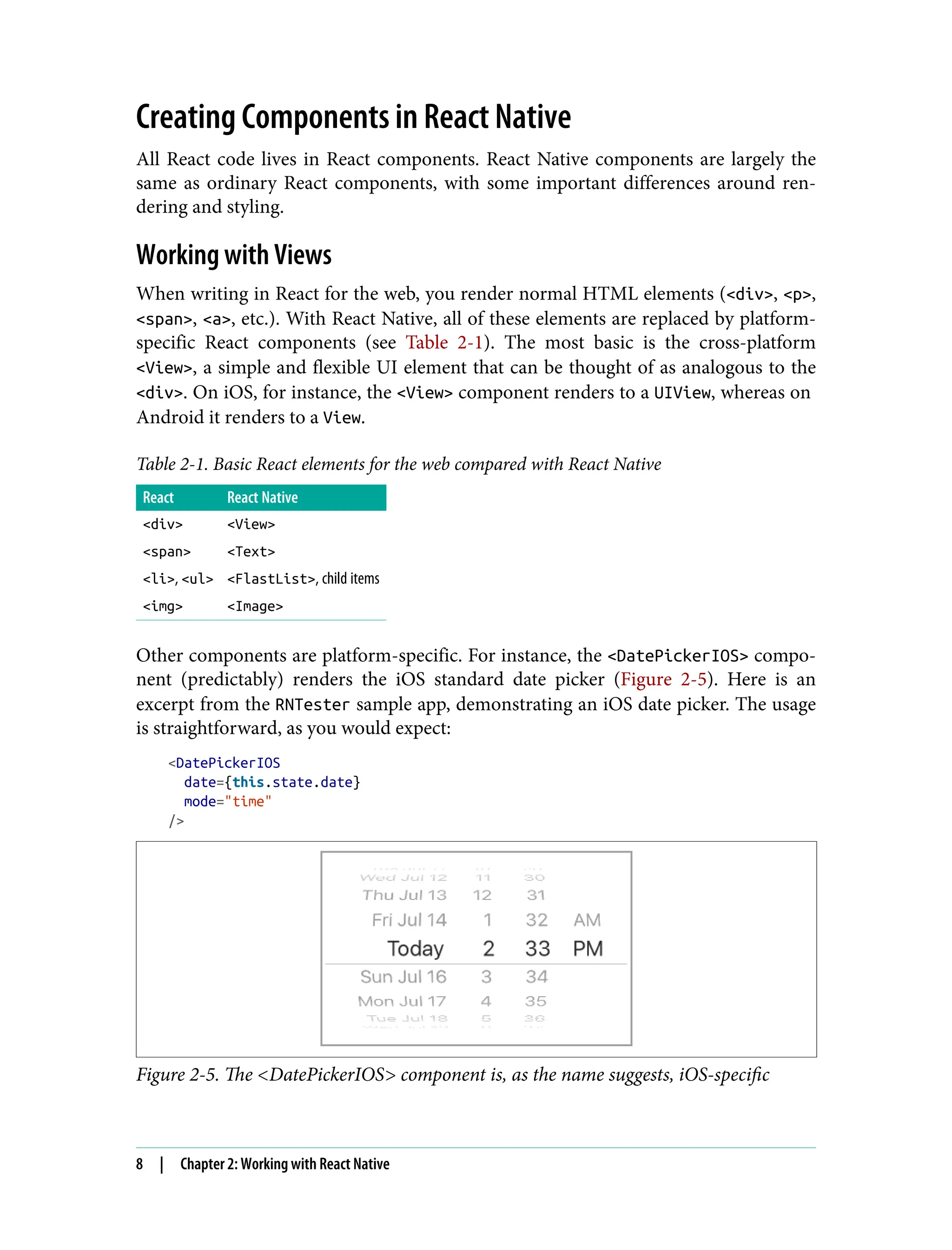


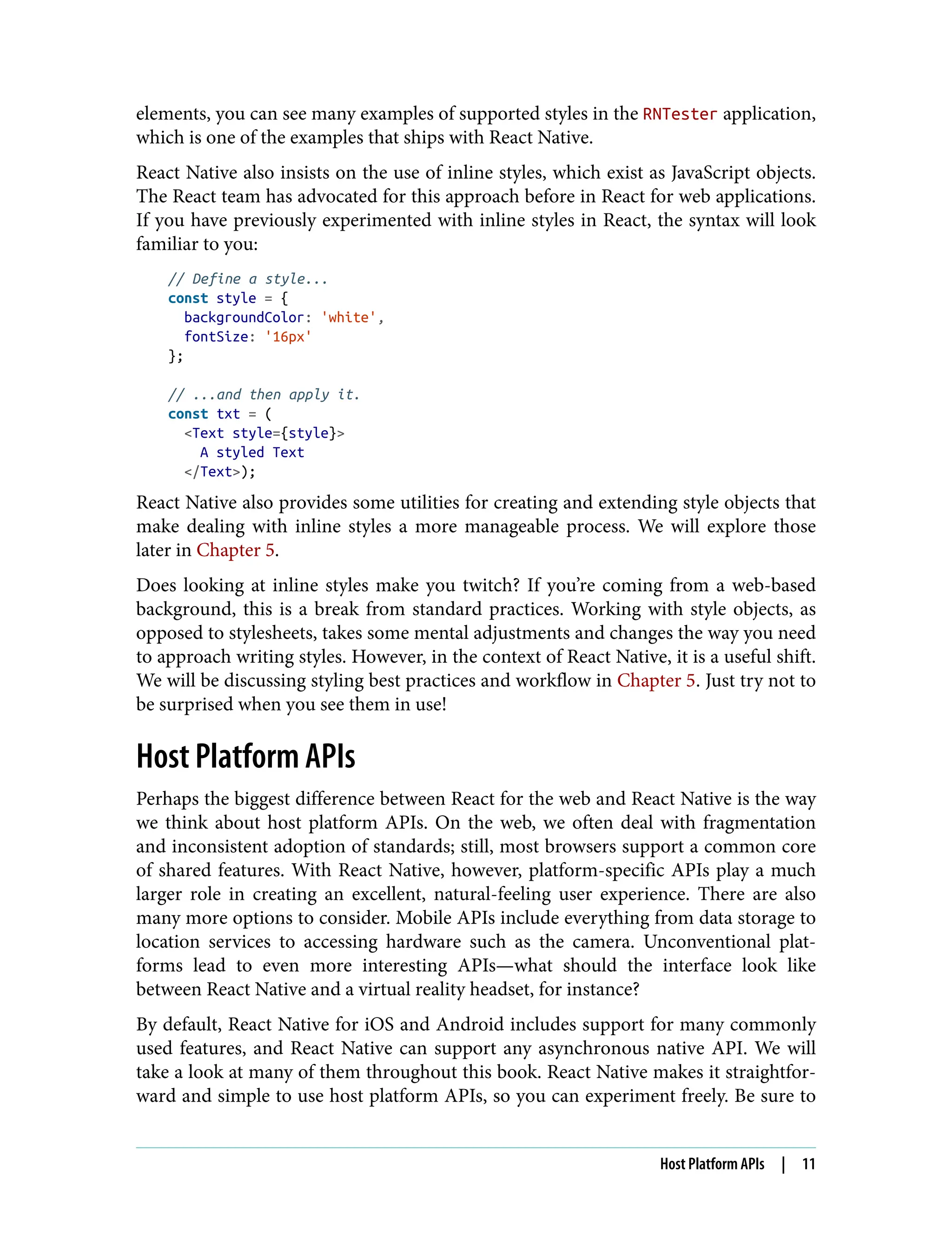

![of temperance, by abstaining, at least, twice a week from the ordinary grosser food with which they are supplied. As might be expected from the age, and from his order, the practice of Chrysostom, and of the numerous other ecclesiastical abstinents from the gross diet of the richer part of the community, reposed upon ascetic and traditionary principles, rather than on the more secular and modern motives of justice, humanity, and general social improvement. So, in fact, Origen, one of the most learned of the Fathers, expressly says (Contra Celsum, v.): “We [the Christian leaders] practise abstinence from the flesh of animals to buffet our bodies and treat them as slaves (ὑπωπιάζομεν καί δουλαγωγοῦμεν), and we wish to mortify our members upon earth,” &c. Accordingly, the Apostolical Canons distinguished, as Bingham (Antiquities of the Christian Church) reports them, between abstinents, διὰ τὴν ἀσκησιν and διὰ τὴν βδελυπίαν, i.e., between those who abstained to exercise self-control, and those who did so from disgust and abhorrence of what, in ordinary and orthodox language, are too complacently and confidently termed “the good creatures of God.” This distinction, it must be added, holds only of the prevailing sentiment of the Orthodox Church as finally established. During several centuries—even so late as the Paulicians in the seventh, or even as the](https://image.slidesharecdn.com/31477-250621061448-bf515544/75/Learning-React-Native-Building-Native-Mobile-Apps-with-JavaScript-2nd-Edition-Bonnie-Eisenman-31-2048.jpg)
![Albigeois of the thirteenth, century—Manicheism, as it is called, or a belief in the inherent evil of all matter, was widely spread in large and influential sections of the Christian Church—nor, indeed, were some of its most famous Fathers without suspicion of this heretical taint. According to the Clementine Homilies, “the unnatural eating of flesh-meat is of demoniacal origin, and was introduced by those giants who, from their bastard nature, took no pleasure in pure nourishment, and only lusted after blood. Therefore the eating of flesh is as polluting as the heathen worship of demons, with its sacrifices and its impure feasts; through participation in which, a man becomes a fellow-dietist (ὁμοδίαιτος) with demons.”[92] That superstition was often, in the minds of the followers both of Plato and of St. Paul, mixed up with, and, indeed, usually dominated over, the reasonable motives of the more philosophic advocates of the higher life, there can be no sort of doubt; nor can we claim a monopoly of rational motives for the mass of the adherents of either Christian or Pythagorean abstinence. Yet an impartial judgment must allow almost equal credit to the earnestness of mind and purity of motive which, mingled though they undoubtedly were with (in the pre-scientific ages) a necessary infusion of superstition, urged the followers of the better way—](https://image.slidesharecdn.com/31477-250621061448-bf515544/75/Learning-React-Native-Building-Native-Mobile-Apps-with-JavaScript-2nd-Edition-Bonnie-Eisenman-32-2048.jpg)
![Christian and non-Christian—to discard the “social lies” of the dead world around them. At all events, it is not for the selfish egoists to sneer at the sublime— if error-infected—efforts of the earlier pioneers of moral progress for their own and the world’s redemption from the bonds of the prevailing vile materialism in life and dietary habits. We have already shown that the earliest Jewish- Christian communities, both in Palestine and elsewhere—the immediate disciples of the original Twelve—enjoined abstinence as one of the primary obligations of the New Faith; and that the earliest traditions represent the foremost of them as the strictest sort of Vegetarians.[93] If then we impartially review the history of the practice, the teaching, and the traditions of the first Christian authorities, it cannot but appear surprising that the Orthodox Church, ignoring the practice and highest ideal of the most sacred period of its annals, has, even within its own Order, deemed it consistent with its claim of being representative of the Apostolic period to substitute partial and periodic for total and constant abstinence. The following passages in the Homilies, or Congregational Discourses, of Chrysostom will serve as specimens of his feeling on the propriety of dietary reform. The eloquent but diffusive style of](https://image.slidesharecdn.com/31477-250621061448-bf515544/75/Learning-React-Native-Building-Native-Mobile-Apps-with-JavaScript-2nd-Edition-Bonnie-Eisenman-33-2048.jpg)
![the Greek Bossuet, it must be noted, is necessarily but feebly represented in the literal English version:— “No streams of blood are among them [the ascetics]; no butchering and cutting up of flesh; no dainty cookery; no heaviness of head. Nor are there horrible smells of flesh- meats among them, or disagreeable fumes from the kitchen. No tumult and disturbance and wearisome clamours, but bread and water—the latter from a pure fountain, the former from honest labour. If, at any time, however, they may wish to feast more sumptuously, the sumptuousness consists in fruits, and their pleasure in these is greater than at royal tables. With this repast [of fruits and vegetables], even angels from Heaven, as they behold it, are delighted and pleased. For if over one sinner who repents they rejoice, over so many just men imitating them what will they not do? No master and servant are there. All are servants—all free men. And think not this a mere form of speech, for they are servants one of another and masters one of another. Wherein, therefore, are we different from, or superior to, Ants, if we compare ourselves with them? For as they care for the things of the body only, so also do we. And would it were for these alone! But, alas! it is for things far worse. For not for necessary things only do we care, but also for things superfluous. Those animals pursue an innocent life, while we follow after all covetousness. Nay, we do not so much as imitate the ways of Ants. We follow the ways of Wolves, the habits of Tigers; or, rather, we are worse even than they. To them Nature has assigned that they should be thus [carnivorously] fed, while God has honoured us with rational speech and a sense of equity. And yet we are become worse than the wild beasts.”[94] Again he protests:—](https://image.slidesharecdn.com/31477-250621061448-bf515544/75/Learning-React-Native-Building-Native-Mobile-Apps-with-JavaScript-2nd-Edition-Bonnie-Eisenman-34-2048.jpg)
![“Neither am I leading you to the lofty peak of total renunciation of possessions [ἀκτημοσύνη]; but for the present I require you to cut off superfluities, and to desire a sufficiency alone. Now, the boundary of sufficiency is the using those things which it is impossible to live without. No one debars you from these, nor forbids you your daily food. I say ‘food,’ not ‘luxury’ [τροφὴν οὐ τρυφὴν λέγω]—‘raiment,’ not ‘ornament.’ Rather, this frugality—to speak correctly—is, in the best sense, luxury. For consider who should we say more truly feasted—he whose diet is herbs, and who is in sound health and suffered no uneasiness, or he who has the table of a Sybarite and is full of a thousand disorders? Clearly, the former. Therefore let us seek nothing more than these, if we would at once live luxuriously and healthfully. And let him who can be satisfied with pulse, and can keep in good health, seek for nothing more. But let him who is weaker, and needs to be [more richly] dieted with other vegetables and fruits, not be debarred from them.... We do not advise this for the harm and injury of men, but to lop off what is superfluous— and that is superfluous which is more than we need. When we are able to live without a thing, healthfully and respectably, certainly the addition of that thing is a superfluity.”—Hom. xix. 2 Cor. Denouncing the grossness of the ordinary mode of living, he eloquently descants on the evil results, physical as well as mental:— “A man who lives in pleasure [i.e., in selfish luxury] is dead while he lives, for he lives only to his belly. In his other senses he lives not. He sees not what he ought to see; he hears not what he ought to hear; he speaks not what he ought to speak.... Look not at the superficial countenance, but examine the interior, and you will see it full of deep](https://image.slidesharecdn.com/31477-250621061448-bf515544/75/Learning-React-Native-Building-Native-Mobile-Apps-with-JavaScript-2nd-Edition-Bonnie-Eisenman-35-2048.jpg)
![dejection. If it were possible to bring the soul into view, and to behold it with our bodily eyes, that of the luxurious would seem depressed, mournful, miserable, and wasted with leanness, for the more the body grows sleek and gross, the more lean and weakly is the soul. The more the one is pampered, the more is the other hampered [θάλπεται— θάπτεται: the latter meaning, literally, buried]. As when the pupil of the eye has the external envelope too thick, it cannot put forth the power of vision and look out, because the light is excluded by the dense covering, and darkness ensues; so when the body is constantly full fed, the soul must be invested with grossness. The dead, say you, corrupt and rot, and a foul pestilential humour distils from them. So in her who lives in pleasure may be seen rheums, and phlegm, and catarrh, hiccough, vomiting, eructations, and the like, which, as too unseemly, I forbear to name. For such is the despotism of luxury, it makes us endure things which we do not think proper even to mention.... “‘She that lives in pleasure is dead while she lives.’ Hear this, ye women[95] who pass your time in revels and intemperance, and who neglect the poor, pining and perishing with hunger, whilst you are destroying yourselves with continual luxury. Thus you are the cause of two deaths—of those who are dying of want and of your own, both through ill-measure. If, out of your fulness, you tempered their want, you would save two lives. Why do you thus gorge your own body with excess, and waste that of the poor with want? Consider what comes of food—into what it is changed. Are you not disgusted at its being named? Why, then, be eager for such accumulations? The increase of luxury is but the multiplication of filth.[96] For Nature has her limits, and what is beyond these is not nourishment, but injury and the increase of ordure. “Nourish the body, but do not destroy it. Food is called nourishment, to show that its purpose is not to hurt, but to](https://image.slidesharecdn.com/31477-250621061448-bf515544/75/Learning-React-Native-Building-Native-Mobile-Apps-with-JavaScript-2nd-Edition-Bonnie-Eisenman-36-2048.jpg)
![support us. For this reason, perhaps, food passes into excrement that we may not be lovers of luxury. If it were not so—if it were not useless and injurious to the body, we should hardly abstain from devouring one another. If the belly received as much as it pleased, digested it, and conveyed it to the body, we should see battles and wars innumerable. Even as it is, when part of our food passes into ordure, part into blood, part into spurious and useless phlegm, we are, nevertheless, so addicted to luxury that we spend, perhaps, whole estates on a meal. The more richly we live, the more noisome are the odours with which we are filled.”—Hom. xiii. Tim. v.[97] From this period—the fifth century A.D. down to the sixteenth—Christian and Western literature contains little or nothing which comes within the purpose of this work. The merits of monastic asceticism were more or less preached during all those ages, although constant abstinence from flesh was by no means the general practice even with the inmates of the stricter monastic or conventual establishments—at all events in the Latin Church. But we look in vain for traces of anything like the humanitarian feeling of Plutarch or Porphyry. The mental intelligence as well as capacities for physical suffering of the non-human races—necessarily resulting from an organisation in all essential points like to our own—was apparently wholly ignored; their](https://image.slidesharecdn.com/31477-250621061448-bf515544/75/Learning-React-Native-Building-Native-Mobile-Apps-with-JavaScript-2nd-Edition-Bonnie-Eisenman-37-2048.jpg)
![just rights and claims upon human justice were disregarded and trampled under foot. Consistently with the universal estimate, they were treated as beings destitute of all feeling—as if, in fine, they are the “automatic machines” they are alleged to be by the Cartesians of the present day. In those terrible ages of gross ignorance, of superstition, of violence, and of injustice—in which human rights were seldom regarded—it would have been surprising indeed if any sort of regard had been displayed for the non- human slaves. And yet an underlying and latent consciousness of the falseness of the general estimate sometimes made itself apparent in certain extraordinary and perverse fancies.[98] To Montaigne, the first to revive the humanitarianism of Plutarch, belongs the great merit of reasserting the natural rights of the helpless slaves of human tyranny. While Chrysostom seems to have been one of the last of Christian writers who manifested any sort of consciousness of the inhuman, as well as unspiritual nature of the ordinary gross foods, Platonism continued to bear aloft the flickering torch of a truer spiritualism; and “the golden chain” of the prophets of the dietary reformation reached down even so late as to the end of the sixth century. Hierokles, author of the commentary on the Golden Verses of Pythagoras, to which reference has already been](https://image.slidesharecdn.com/31477-250621061448-bf515544/75/Learning-React-Native-Building-Native-Mobile-Apps-with-JavaScript-2nd-Edition-Bonnie-Eisenman-38-2048.jpg)
![made, and who lectured upon them with great success at Alexandria; Hypatia, the beautiful and accomplished daughter of Theon the great mathematician, who publicly taught the philosophy of Plato at the same great centre of Greek science and learning, and was barbarously murdered by the jealousy of her Christian rival Cyril, Archbishop of Alexandria; Proklus, surnamed the Successor, as having been considered the most illustrious disciple of Plato in the latter times, who left several treatises upon the Pythagorean system, and “whose sagacious mind explored the deepest questions of morals and metaphysics”;[99] Olympiodorus, who wrote a life of Plato and commentaries on several of his dialogues, still extant, and lived in the reign of Justinian, by whose edict the illustrious school of Athens was finally closed, and with it the last vestiges of a sublime, if imperfect, attempt at the purification of human life—such are some of the most illustrious names which adorned the days of expiring Greek philosophy. Olympiodorus and six other Pythagoreans determined, if possible, to maintain their doctrines elsewhere; and they sought refuge with the Persian Magi, with whose tenets, or, at least, manner of living, they believed themselves to be most in accord. The Persian customs were distasteful to the purer ideal of the Platonists, and, disappointed in](https://image.slidesharecdn.com/31477-250621061448-bf515544/75/Learning-React-Native-Building-Native-Mobile-Apps-with-JavaScript-2nd-Edition-Bonnie-Eisenman-39-2048.jpg)
![other respects, they reluctantly relinquished their fond hopes of transplanting the doctrines of Plato into a foreign soil, and returned home. The Persian prince, Chosroes, we may add, acquired honour by his stipulation with the bigoted Justinian, that the seven sages should be allowed to live unmolested during the rest of their days. “Simplicius and his companions ended their lives in peace and obscurity; and, as they left no disciples, they terminated the long list of Grecian philosophers who may be justly praised, notwithstanding their defects, as the wisest and most virtuous of their contemporaries. The writings of Simplicius are now extant. His physical and metaphysical commentaries on Aristotle have passed away with the fashion of the times, but his moral interpretation of Epiktetus is preserved in the library of nations as a classical book excellently adapted to direct the will, to purify the heart, and to confirm the understanding, by a just confidence in the nature both of God and Man.”[100]](https://image.slidesharecdn.com/31477-250621061448-bf515544/75/Learning-React-Native-Building-Native-Mobile-Apps-with-JavaScript-2nd-Edition-Bonnie-Eisenman-40-2048.jpg)


![other excesses. His constitution had been so impaired, and he had brought upon himself so many disorders by this course of living, that existence became a burden to him. He informs us that from his thirty-fifth to his fortieth year he passed his nights and days in continuous suffering. Every sort of known remedy was exhausted before his new medical adviser, superior to the prejudices of his profession and of the public, had the courage and the good sense to prescribe a total change of diet. At first Cornaro found his enforced regimen almost intolerable, and, as he tells us, he occasionally relapsed. These relapses brought back his old sufferings, and, to save his life, he was driven at length to practise entire and uniform abstinence, the yolk of an egg often furnishing him the whole of his meal. In this way he assures us that he came to relish dry bread more than formerly he had enjoyed the most exquisite dishes of the ordinary table. At the end of the first year he found himself entirely freed from all his multiform maladies. In his eighty-third year he wrote and published his first exhortation to a radical change of diet under the title of A Treatise on a Sober Life,[101] in which he eloquently narrates his own case, and exhorts all who value health and immunity from physical or mental sufferings to follow](https://image.slidesharecdn.com/31477-250621061448-bf515544/75/Learning-React-Native-Building-Native-Mobile-Apps-with-JavaScript-2nd-Edition-Bonnie-Eisenman-43-2048.jpg)
![his example. And his exordium, in which he takes occasion to denounce the waste and gluttony of the dinners of the rich, might be applied with little, or without any, modification of its language to the public and private tables of the present day:— “It is very certain,” he begins, “that Custom, with time, becomes a second nature, forcing men to use that, whether good or bad, to which they have been habituated; and we see custom or habit get the better of reason in many things.... Though all are agreed that intemperance (la crapula) is the offspring of gluttony, and sober living of abstemiousness, the former nevertheless is considered a virtue and a mark of distinction, and the latter as dishonourable and the badge of avarice. Such mistaken notions are entirely owing to the power of Custom, established by our senses and irregular appetites. These have blinded and besotted men to such a degree that, leaving the paths of virtue, they have followed those of vice, which lead them imperceptibly to an old age burdened with strange and mortal diseases.... “O wretched and unhappy Italy! [thus he apostrophises his own country] can you not see that gluttony murders every year more of your inhabitants than you could lose by the most cruel plague or by fire and sword in many battles? Those truly shameful feasts (i tuoi veramente disonesti banchetti), now so much in fashion and so intolerably profuse that no tables are large enough to hold the infinite number of the dishes—those feasts, I say, are so many battles.[102] And how is it possible to live amongst such a multitude of jarring foods and disorders? Put an end to this abuse, in heaven’s name, for there is not—I am certain of it—a vice more abominable than this in the eyes of the divine Majesty. Drive](https://image.slidesharecdn.com/31477-250621061448-bf515544/75/Learning-React-Native-Building-Native-Mobile-Apps-with-JavaScript-2nd-Edition-Bonnie-Eisenman-44-2048.jpg)
![away this plague, the worst you were ever afflicted with—this new [?] kind of death—as you have banished that disease which, though it formerly used to make such havoc, now does little or no mischief, owing to the laudable practice of attending more to the goodness of the provisions brought to our markets. Consider that there are means still left to banish intemperance, and such means, too, that every man may have recourse to them without any external assistance. “Nothing more is requisite for this purpose than to live up to the simplicity, dictated by nature, which teaches us to be content with little, to pursue the practice of holy abstemiousness and divine reason, and accustom ourselves to eat no more than is absolutely necessary to support life; considering that what exceeds this is disease and death, and done merely to give the palate a satisfaction which, though but momentary, brings on the body a long and lasting train of disagreeable diseases, and at length kills it along with the soul. How many friends of mine—men of the finest understanding and most amiable disposition—have I seen carried off by this plague in the flower of their youth! who, were they now living, would be an ornament to the public, and whose company I should enjoy with as much pleasure as I am now deprived of it with concern.” He tells us that he had undertaken his arduous task of proselytising with the more anxiety and zeal that he had been encouraged to it by many of his friends, men of “the finest intellect” (di bellissimo intelletto), who lamented the premature deaths of parents and relatives, and who observed so manifest a proof of the advantages of abstinence in the robust and vigorous frame of the dietetic missionary at the](https://image.slidesharecdn.com/31477-250621061448-bf515544/75/Learning-React-Native-Building-Native-Mobile-Apps-with-JavaScript-2nd-Edition-Bonnie-Eisenman-45-2048.jpg)
![age of eighty. Cornaro was a thorough-going hygeist, and he followed a reformed diet in the widest meaning of the term, attending to the various requirements of a healthy condition of mind and body:— “I likewise,” he says with much candour, “did all that lay in my power to avoid those evils which we do not find it so easy to remove—melancholy, hatred, and other violent passions which appear to have the greatest influence over our bodies. However, I have not been able to guard so well against either one or the other kind of these disorders [passions] as not to suffer myself now and then to be hurried away by many, not to say all, of them; but I reaped one great benefit from my weakness—that of knowing by experience that these passions have, in the main, no great influence over bodies governed by the two foregoing rules of eating and drinking, and therefore can do them but very little harm, so that it may, with great truth, be affirmed that whoever observes these two capital rules is liable to very little inconvenience from any other excess. This Galen, who was an eminent physician, observed before me. He affirms that so long as he followed these two rules relative to eating and drinking (perchè si guardava da quelli due della bocca) he suffered but little from other disorders—so little that they never gave him above a day’s uneasiness. That what he says is true I am a living witness; and so are many others who know me, and have seen how often I have been exposed to heats and colds and such other disagreeable changes of weather, and have likewise seen me (owing to various misfortunes which have more than once befallen me) greatly disturbed in mind. For not only can they say of me that such mental disturbance has affected me little, but they can aver of many others who did not lead a frugal and regular life that such failure proved very prejudicial to](https://image.slidesharecdn.com/31477-250621061448-bf515544/75/Learning-React-Native-Building-Native-Mobile-Apps-with-JavaScript-2nd-Edition-Bonnie-Eisenman-46-2048.jpg)
![them, among whom was a brother of my own and others of my family who, trusting to the goodness of their constitution, did not follow my way of living.” At the age of seventy a serious accident befel him, which to the vast majority of men so far advanced in life would probably have been fatal. His coach was overturned, and he was dragged a considerable distance along the road before the horses could be stopped. He was taken up insensible, covered with severe wounds and bruises and with an arm and leg dislocated, and altogether he was in so dangerous a state that his physicians gave him only three days to live. As a matter of course they prescribed bleeding and purging as the only proper and effectual remedies:— “But I, on the contrary, who knew that the sober life I had led for many years past had so well united, harmonised, and dispersed my humours as not to leave it in their power to ferment to such a degree [as to induce the expected high fever], refused to be either bled or purged. I simply caused my leg and arm to be set, and suffered myself to be rubbed with some oils, which they said were proper on the occasion. Thus, without using any other kind of remedy, I recovered, as I thought I should, without feeling the least alteration in myself or any other bad effects from the accident, a thing which appeared no less than miraculous in the eyes of the physicians.”](https://image.slidesharecdn.com/31477-250621061448-bf515544/75/Learning-React-Native-Building-Native-Mobile-Apps-with-JavaScript-2nd-Edition-Bonnie-Eisenman-47-2048.jpg)
![It is, perhaps, hardly to be expected that “The Faculty” will endorse the opinions of Cornaro, that any person by attending strictly to his regimen “could never be sick again, as it removes every cause of illness; and so, for the future, would never want either physician or physic”:— “Nay, by attending duly to what I have said he would become his own physician, and, indeed, the best he could have, since, in fact, no man can be a perfect physician to anyone but himself. The reason of which is that any man may, by repeated trials, acquire a perfect knowledge of his own constitution and the most hidden qualities of his body, and what food best agrees with his stomach. Now, it is so far from being an easy matter to know these things perfectly of another that we cannot, without much trouble, discover them in ourselves, since a great deal of time and repeated trials are required for that purpose.” Cornaro’s second publication appeared three years later than his first, under the title of A Compendium of a Sober Life and the third, An Earnest Exhortation to a Sober and Regular Life,[103] in the ninety-third year of his age. In these little treatises he repeats and enforces in the most earnest manner his previous exhortations and warnings. He also takes the opportunity of exposing some of the plausible sophisms employed in defence of luxurious living:—](https://image.slidesharecdn.com/31477-250621061448-bf515544/75/Learning-React-Native-Building-Native-Mobile-Apps-with-JavaScript-2nd-Edition-Bonnie-Eisenman-48-2048.jpg)
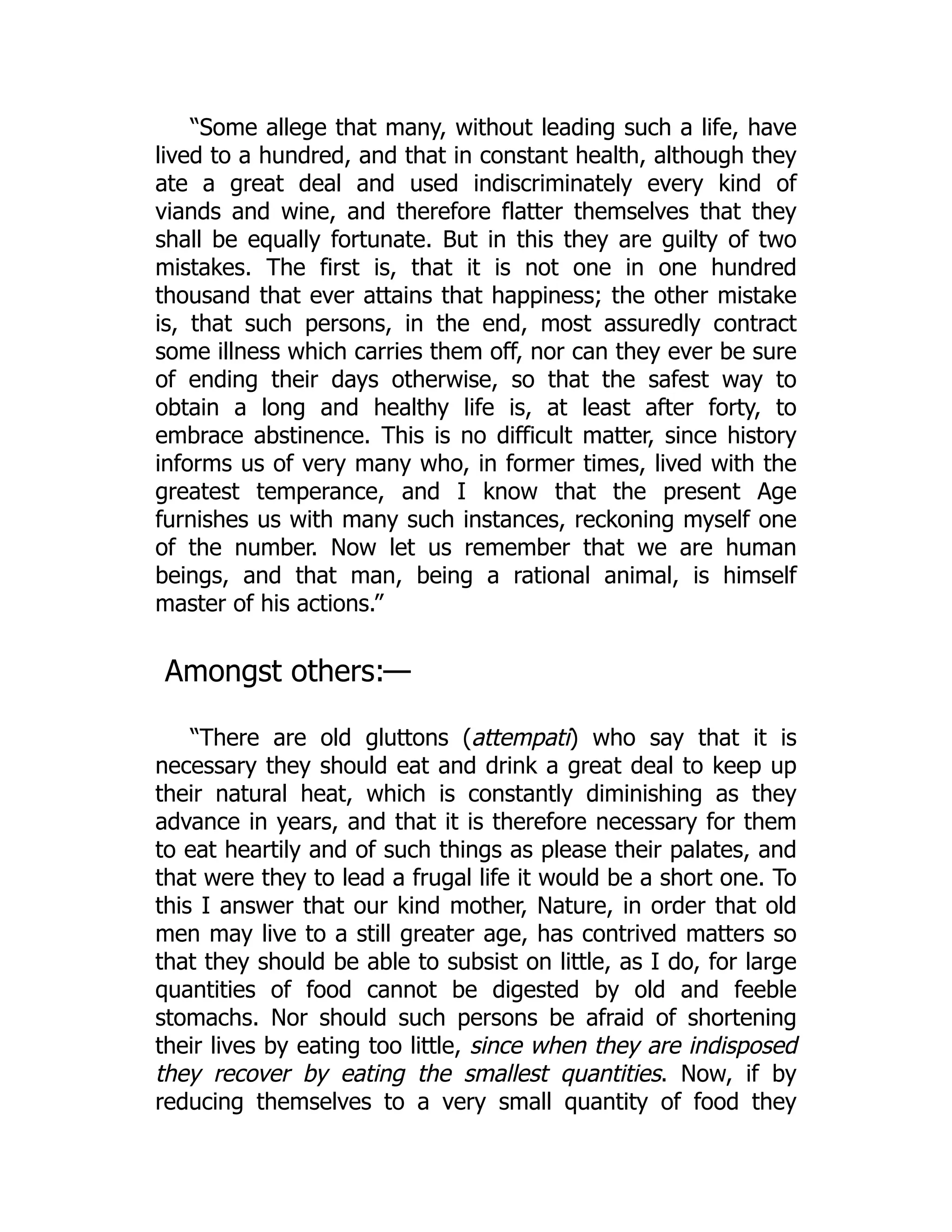
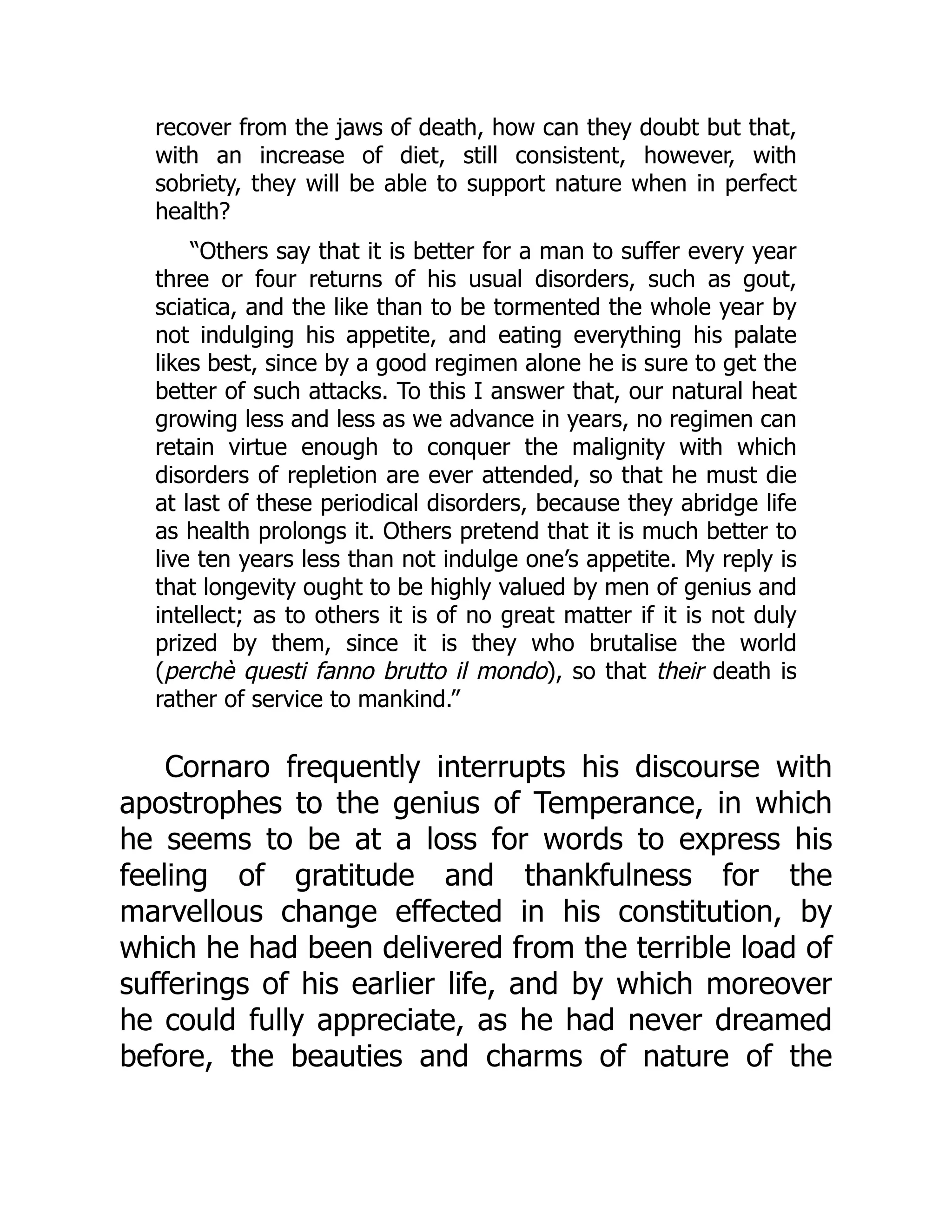
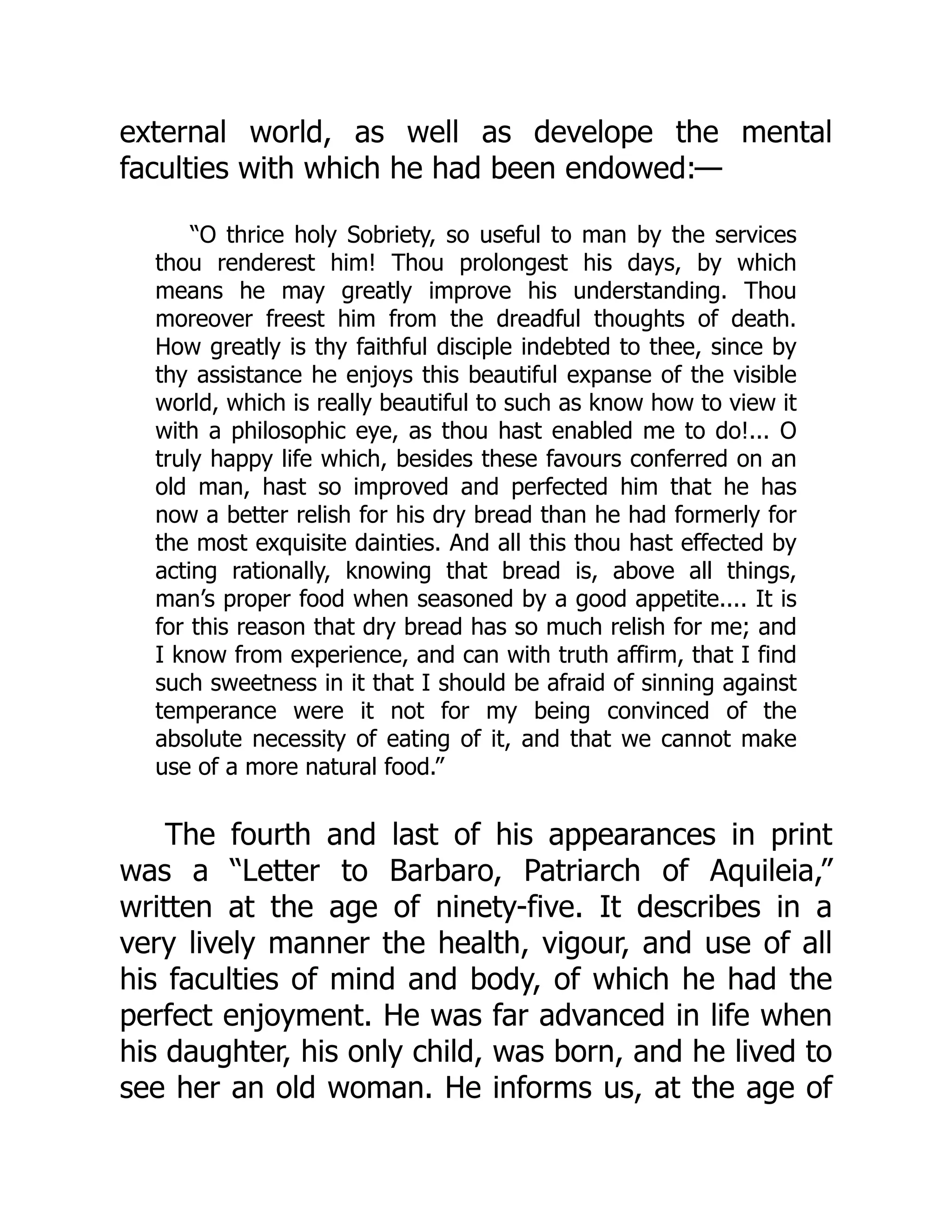
![ninety-one, with much eloquence and enthusiasm of the active interest and pleasure he experienced in all that concerned the prosperity of his native city: of his plans for improving its port; for draining, recovering, and fertilizing the extensive marshes and barren sands in its neighbourhood. He died, having passed his one hundredth year, calmly and easily in his arm- chair at Padua in the year 1566.[104] His treatises, forming a small volume, have been “very frequently published in Italy, both in the vernacular Italian and in Latin. It has been translated into all the civilised languages of Europe, and was once a most popular book. There are several English translations of it, the best being one that bears the date 1779. Cornaro’s system,” says the writer in the English Cyclopædia whom we are quoting, “has had many followers.” Recounting his many dignities and honours, and the distinguished part he took in the improvement of his native city, by which he acquired a great reputation amongst his fellow-citizens, the Italian editor of his writings justly adds:— “But all these fine prerogatives of Luigi Cornaro would not have been sufficient to render his name famous in Europe if he had not left behind him the short treatises upon Temperance, composed at various times at the advanced ages of 85, 86, 91, and 95. The candour which breathes through their simplicity, the importance of the argument, and the fervour with which he urges upon all to study the means of](https://image.slidesharecdn.com/31477-250621061448-bf515544/75/Learning-React-Native-Building-Native-Mobile-Apps-with-JavaScript-2nd-Edition-Bonnie-Eisenman-52-2048.jpg)





![prevention rather than punishment, and denounced the monstrous inequality of penalties by which thieving was placed in the same category with murder and crimes of violence:— “For great and horrible punishments be awarded to thieves, whereas much rather provision should have been made that there were some means whereby they might get their living, so that no man should be driven to this extreme necessity—first to steal and then to die.... By suffering your youth to be wantonly and viciously brought up and to be infected, even from their tender age, by little and little with vice—then, in God’s name, to be punished when they commit the same faults after being come to man’s state, which from their youth they were ever like to do—in this point, I pray you, what other thing do you than make thieves and then punish them.”[105] What we are immediately concerned with here is his feeling in regard to slaughter. The Utopians condemn— “Hunters also and hawkers (falconers), for what delight can there be, and not rather displeasure, in hearing the barking and howling of dogs? Or what greater pleasure is there to be felt when a dog follows a hare than when a dog follows a dog? For one thing is done by both—that is to say, running, if you have pleasure in that. But if the hope of slaughter and the expectation of tearing the victim in pieces pleases you, you should rather be moved with pity to see an innocent hare murdered by a dog—the weak by the strong, the fearful by the fierce, the innocent by the cruel and pitiless.[106] Therefore this exercise of hunting, as a thing](https://image.slidesharecdn.com/31477-250621061448-bf515544/75/Learning-React-Native-Building-Native-Mobile-Apps-with-JavaScript-2nd-Edition-Bonnie-Eisenman-58-2048.jpg)
![unworthy to be used of free men, the Utopians have rejected to their butchers, to the which craft (as we said before) they appoint their bondsmen. For they count hunting the lowest, the vilest, and most abject part of butchery; and the other parts of it more profitable and more honest as bringing much more commodity, in that they (the butchers) kill their victims from necessity, whereas the hunter seeks nothing but pleasure of the seely [simple, innocent] and woful animal’s slaughter and murder. The which pleasure in beholding death, they say, doth rise in wild beasts, either of a cruel affection of mind or else by being changed, in continuance of time, into cruelty by long use of so cruel a pleasure. These, therefore, and all such like, which be innumerable, though the common sort of people do take them for pleasures, yet they, seeing that there is no natural pleasantness in them, plainly determine them to have no affinity with true and right feeling.” In telling us that his model people “permit not their free citizens to accustom themselves to the killing of ‘beasts’ through the use whereof they think clemency, gentlest affection of our nature, by little and little to decay and perish,”[107] More for ever condemns the immorality of the Slaughter-House, whether he intended to do so in toto or no. In relegating the business of slaughter to their bondsmen (criminals who had been degraded from the rights of citizenship), the Utopians, we may observe, exhibit less of justice than of refinement. To devolve the trade of slaughter upon a pariah-class is not the least immoral of the necessary concomitants](https://image.slidesharecdn.com/31477-250621061448-bf515544/75/Learning-React-Native-Building-Native-Mobile-Apps-with-JavaScript-2nd-Edition-Bonnie-Eisenman-59-2048.jpg)


![truthfully attributed to the one sufficient cause—to the general indulgence of selfish instincts, which closes the ear to all the promptings at once of humanity and of reason, and is, in truth, a national sin of the most serious character.[108] The “wisdom of our ancestors,” which has been so often invoked, both before and since the days of More, and which Bentham has so mercilessly exposed, apparently did not subdue the reason of the author of Utopia; yet, with no little amount of applause it has been made to serve as a very conclusive argument against dietetic reformation, as against many other changes:— “‘These things,’ say they, ‘pleased our forefathers and ancestors—would to God we could be so wise as they were!’ And, as though they had wittily concluded the matter, and with this answer stopped every man’s mouth, they sit down again as who should say, ‘It were a very dangerous matter if a man in any point should be found wiser than his forefathers were.’ And yet be we content to suffer the best and wittiest [wisest] of their decrees to be unexecuted; but if in anything a better order might have been taken than by them was, there we take fast hold, finding therein many virtues.”[109]](https://image.slidesharecdn.com/31477-250621061448-bf515544/75/Learning-React-Native-Building-Native-Mobile-Apps-with-JavaScript-2nd-Edition-Bonnie-Eisenman-62-2048.jpg)

